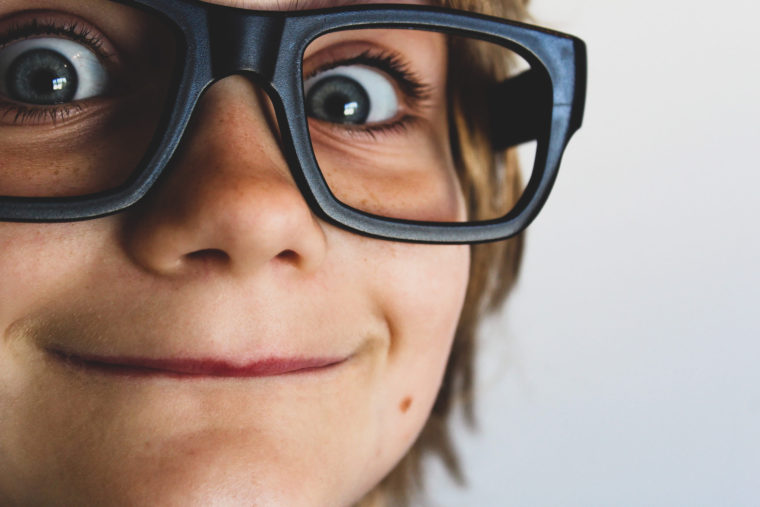Up to 300,000 children in the US alone are affected by a lazy eye.

In my article yesterday, I noted six important vision tests a child should be given to determine vision readiness for learning success. One of the conditions that negatively impacts a child’s vision and can be discovered during this comprehensive assessment is a lazy eye.
What is a Lazy Eye?
When looking at someone with a lazy eye, you will notice that one eye tends to wander either outward or inward. This condition generally develops between birth to age seven years.
A lazy eye occurs when the neural connections between the eye and the brain are interrupted. When that happens, one eye is unable to achieve normal visual acuity, that is, the sharpness of vision at 3 distances – near, intermediate, and far.
Rachel’s Dilemma
When Rachel was 7 years old, she had her regular elementary school eye screening. The doctor told her that she had a lazy eye. She didn’t know what that meant, and no one took the time to enlighten her. Her parents took her to an eye doctor who prescribed eyeglasses for her.
For the next twelve years, Rachel wore her eyeglasses, with no improvement in her vision. She had trouble with depth perception, coordinating her eyes and her hands, and even difficulty catching a ball.
She decided to visit two different eye doctors upon graduation from high school. They both told her that her eyes did not work together, did not change her glasses prescription but advised her to continue wearing them. Discouraged and dejected, she made up her mind to live with her problems.
At the age of 33, she moved to New York City. While talking with her new friends, she mentioned her lazy eye. Some of them reported that they used to have a lazy eye. Looking at them, she could see no evidence of that, so her interest was stirred.
After questioning them, she learned that they had gone to and received therapy from a developmental optometrist for a period of time, following which the lazy eye was corrected.
3 Negative Effects of a Lazy Eye:
- A lack of convergence.
- Both eyes must work together to focus on near objects easily. This is essential for reading the page of a book or watching television.
- Poor eye-hand coordination.
- The eyes are unable to adequately use visual input to direct the hands. In other words, the eyes and hands are not working together smoothly.
- This is important for writing, drawing a picture, or hitting a ball.
- Deficient reading.
- A lack of convergence and poor eye-hand coordination slows down the reader, thus also slowing down learning.
3 Ways to Correct a Lazy Eye
- Eyeglasses.
- This is the default method of most eye doctors.
- This helps with visual acuity but does not solve the problem.
- An eye patch.
- This is placed over the stronger eye for a few hours over several months, to force the lazy eye to work harder, thus developing the neural pathway in the brain.
- It won’t get rid of the eye turn but will improve vision in the lazy eye.
- Vision therapy
- This treatment is provided by a developmental optometrist.
- The prescribed exercises are done at the doctor’s office and at home.
- This method can be used in combination with others.
Reading enhances the imagination. It is also fundamental for academic achievement. It is the springboard for any child to reach his potential.
Although there are other methods of reading, most school systems usually focus on print reading. When a child is unable to read print efficiently and effectively, she is usually left behind and struggles more and more as she advances in grade level.
From kindergarten to grade three children learn to read, but from grade four onward, they read to learn. Correcting seemingly small issues, like a lazy eye, can positively impact a child for a lifetime.

Hello again Florence. I see that you are working the night shift again with me.
After the massive storm yesterday, I had a long day today, Doug. But I was determined to complete my post for the day. Regardless, it’s always a pleasure interacting with you. 😊
Florence-
What an important topic to write about. I get the eyesite thing. I had my first pair of glasses at age 10. It helped me read the board across the classroom. Then I got bifocals with the bottom half helping me read upclose. At 16 I was able to wear contact lens and that freed me up for my tennis playing. Lucky for me, my hand eye was never affected as you write about, but I have always wanted to have “regular” vision.
Glad to have found your post! Way to go!
Thanks for your support, Anne. I started wearing glasses at eight years, and have longed for “regular” vision also. I am too afraid of eye infections to even try contact lenses.
Wow, I didn’t realize that was something that could be fixed. I knew someone growing up who had a lazy eye, I don’t know if she ever had therapy but it’s a very interesting post.
Apparently, lazy-eye correction is not common knowledge. If only more parents knew this, many children would be spared not only vision problems but also self-esteem issues.
Great information for everyone that has young ones! Thanks for sharing.
Thanks for your support, Martha. I hope your grandchildren can benefit from the information. Please share it with those around you with little ones.